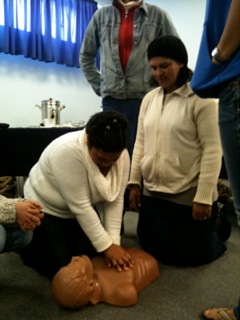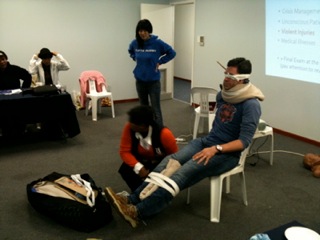By McKenzie Wilson
“Once in a lifetime comes often, so be prepared.” -Old English Proverb
That “once in a lifetime” is often the chance to save a life. It can be anywhere, at anytime—a car accident, cardiac arrest, a gunshot—these scenarios are common medical emergencies, all of which are successfully treated on a routine basis in developed countries. These response systems assume the preparation, training, and competence of medical personnel, and also their timely arrival on the scene. Indeed, the successful recognition and treatment of medical emergencies can hinge upon a matter of seconds in ambulance response time.

These assumptions cannot be made in parts of the world without reliable access to emergency response resources. Stanford alumnus and Fulbright Scholar Jared Sun identified this need for a prepared response system to medical emerg
encies in Cape Town, South Africa. Recognizing that the best and most effective life-saving technologies are often at the hands of community members, Sun developed the Emergency First Aid Response System (EFAR) in the township of Manenberg, South Africa, just outside Cape Town, in 2009. Intended to train commu
nity members as emergency first aid responders (EFARs), the program was organized “as a massive expansion of a simple first aid training course started by six Stanford University students back in 2008…to sustainably equip Manenberg township residents with the emergency skills needed to keep near-death patients alive until higher care was available.”1
Through March 2011, EFAR, with the help of the University of Cape Town, Stellenbosch University, and the Emergency Medicine Society of South Africa, had certified over 700 community members as EFARs. 1 These EFARs are assigned to different sections of the community divided into blocks, defined as “clusters of residences in which residents are somewhat familiar with one another,” and stations, larger block clusters.1 As ordinary community members who have chosen to receive basic first aid training, EFARs are expected to provide immediate basic care in medical emergencies until certified medical personnel arrive.
The inconsistent and unreliable response time of ambulances and other emergency services in the Cape Town area mean that an EFAR might provide basic care for a few minutes or even a few hours. A lack of consistent funding means that particularly in slum areas, ambulances or other emergency services may take hours to arrive on the scene.
The EFAR system’s strength and potential lie in its sustainable organization and set-up, helping it to bypass some of the funding concerns that have plagued other emergency response systems. Still, Sun noted that initial funding for the project was easy to come by compared to the challenge of making the organization self-sufficient and continuous.

To attain sustained outside funding, an effort such as Sun’s must necessarily convince a funder of its long-term value.
In many developing countries, until recently, vertical programs guided by global health policy have concentrated on maternal and child health and the control of communicable diseases rather than the expedient treatment of medical emergencies such as cardiac arrest, road traffic accidents, and self-inflicted injuries, all of which are chief emergency department complaints in developed countries. Slowly, governments have also begun to acknowledge the importance of addressing these problems that might limit a country’s human resources. Fortunately for Sun, UCT’s head of the emergency department is also the government head of emergency medicine, “so funds to continue, run, and maintain the project came from his department,” involving both the UCT and South African government in the sustainable funding and running of the EFAR project. Indeed, the interconnectedness of the government and academic programming in South Africa have meant “the system has been ideal,” from Sun’s perspective, especially since his preferred funder would be the government because “that’s where the money is, and their involvement is a sign that they are invested in its sustainability.”
Self-sufficiency has always been a primary concern for health services projects, and yet it often still remains an elusive goal, with funding, personnel resources, and continued support often difficult to consistently come by, especially in developing, resource-strained countries. According to Sun, “a lot of projects make the mistake of creating an intervention that is parallel and not connected with an endeavor of the government is already doing.” The importance of asking local recipients what they want is often overlooked, although it is a critical factor in a project’s self-sufficiency and continuity. Without support at the local level, financial backing from the regional, national, or international level is of little importance.
Though there is certainly no proven recipe for success, local support is also crucial for a sustainable program. Although EFAR’s services are designed to benefit locals, ultimately they are the ones responsible for maintaining it.
“I think the overarching philosophy is to think globally and locally,” said Sun. “We’re empowering local organizations in smaller regions to set up the EFAR system for themselves, with the idea that as many of these systems spring up, it will be rolled out across a population.” EFAR fills those once-in-a-lifetime moments of emergencies with knowledgeable care from prepared citizens.
References:
1. “Emergency First Aid Responder System.” [Executive Summary]. 3 March 2011
